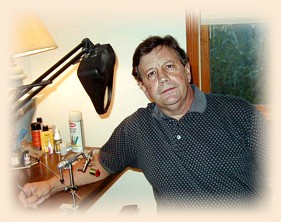
|
The Romany Rye and The Romany Ree By Eric Austin, Ohio |
|
"Mr. Cassard has also invented two similar patterns that are excellent bass flies, which he calls the Romany Rye and Romany Ree, both having wings of the black barred feathers of the wood duck, like those of the Matador."
"During the time I was spending hours on end in research on fly patterns, I happened to find mention of the Romany Rye and the Romany Ree. At first, the names seemed to indicate the possibility of British origin; however, so little information was available, I began a search in an effort to find at least additional mention of the name. Eventually two references were found; one alluded to the probability that the flies were named after the nicknames given by the English to a Gypsy man and woman, while the other suggested the likelihood that they were of American origin. Favorite Flies, a masterpiece in the exposition of fly lore, written by Mary Orvis Marbury, contained an account explaining that these flies were the inventions of Mr. William J. Cassard of New York City who also designed the Matador and the Cassard. The Orvis people of Manchester, Vermont, were kind enough to cooperate by searching their files for further clues to the true dressing of these two flies. Mr. C.W. Shafer, then treasurer of the Orvis Company, explained that he had succeeded in finding one Romany Rye which had been tied for the exhibit of the Orvis line of flies at the World's Fair in 1893, and that he would have one tied according to the original pattern. I received this shortly thereafter, and entered the dressing in the Dictionary of Patterns, exactly according to this sample. Unfortunately the Romany Ree, a variation of the Romany Rye, is nowhere described in the reams of notes I have collected nor in any of the volumes at my disposal. Since the sample sent to me by Mr. Shafer was tagged, "Romany Rye" or "Romany Ree," I indexed the two flies accordingly."
Romany Rye
Tip: Yellow floss. Tail: Peacock herl over married red and white goose. Butt: Peacock herl. Ribbing: Silver twist Body: Silver tinsel. Thorax: Pink chenille. Hackle: Badger. Wing: Barred wood duck, golden pheasant tippet shoulders. ~ EA
About Eric: I started fly fishing as a teen in and around my hometown
of Plattsburgh, New York, primarily on the Saranac River.
I started tying flies almost immediately and spent hours
with library books written by Ray Bergman, Art Lee, and
A. J. McClane. Almost from the beginning I liked tying
just as much as I liked fishing and spent considerable
time at the vise creating hideous monstrosities that
somehow caught fish anyway. Then one day I came upon a
group of flies that had been put out at a local drug store
that had been tied by Francis Betters of Wilmington, N.Y.
My life changed that day and so did my flies, dramatically.
Even though I never met Fran back then, I've always
considered him to be one of my biggest influences.
I started fly fishing as a teen in and around my hometown
of Plattsburgh, New York, primarily on the Saranac River.
I started tying flies almost immediately and spent hours
with library books written by Ray Bergman, Art Lee, and
A. J. McClane. Almost from the beginning I liked tying
just as much as I liked fishing and spent considerable
time at the vise creating hideous monstrosities that
somehow caught fish anyway. Then one day I came upon a
group of flies that had been put out at a local drug store
that had been tied by Francis Betters of Wilmington, N.Y.
My life changed that day and so did my flies, dramatically.
Even though I never met Fran back then, I've always
considered him to be one of my biggest influences.
|